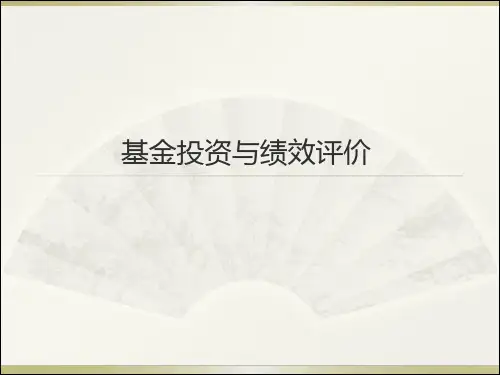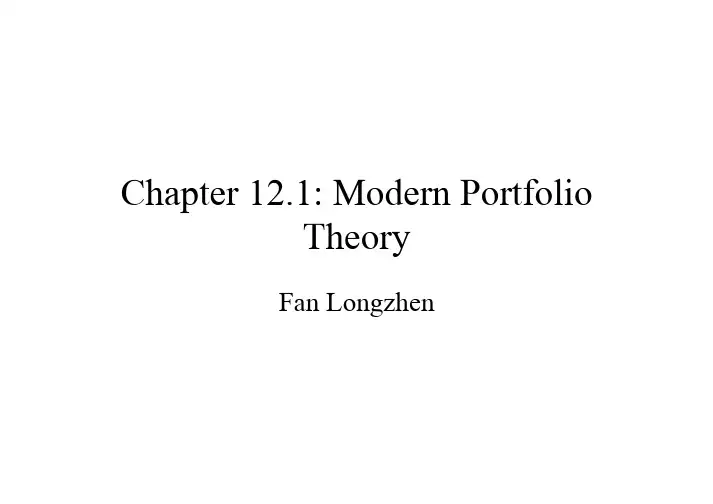复旦大学研究生课件 - 投资学
- 格式:pdf
- 大小:54.11 MB
- 文档页数:446
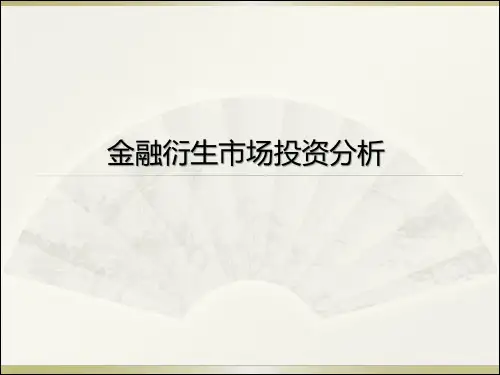
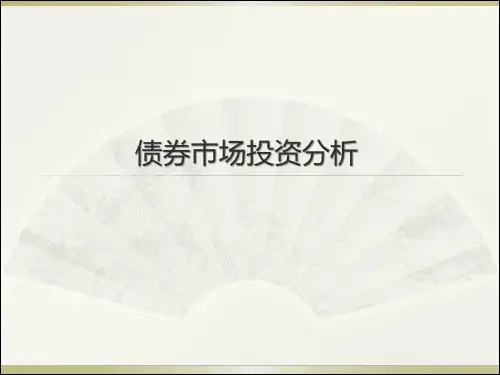
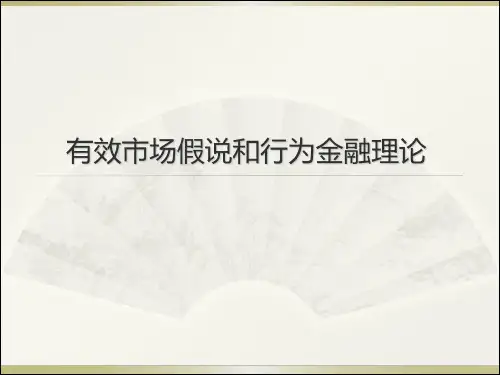
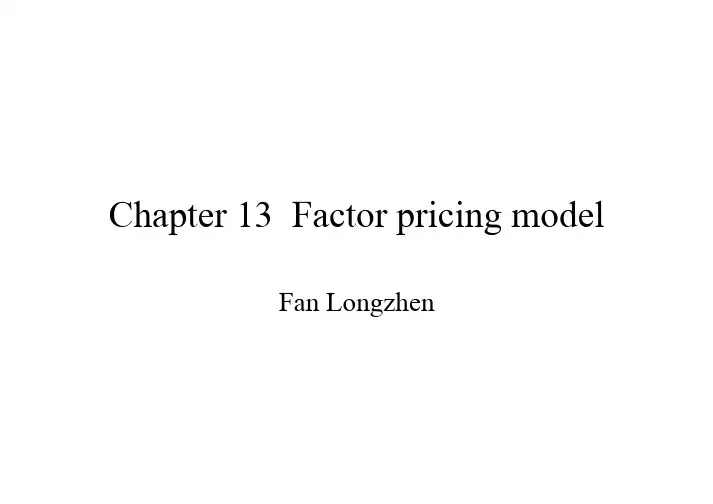
Chapter 13 Factor pricing modelFan LongzhenIntroduction•The consumption-based model as a complete answer to most asset pricing question in principle, does not work well in practice;•This observation motivates effects to tie the discount factor m to other data;•Linear factor pricing models are most popular models of this sort in finance;•They dominate discrete-time empirical work.Factor pricing models•Factor pricing models replace the consumption-based expression for marginal utility growth with a linear model of the form•The key question: what should one use for factors 11'+++=t t f b a m 1+t fCapital asset pricing model (CAPM)•CAPM is the model , is the wealth portfolio return.•Credited Sharpe (1964) and Linterner (1965), is the first, most famous, and so far widely used model in asset pricing.•Theoretically, a and b are determined to price any two assets, such as market portfolio and risk free asset.•Empirically, we pick a,b to best price larger cross section of assets;•We don’t have good data, even a good empirical definition for wealth portfolio, it is often deputed by a stock index;•We derive it from discount factor model by •(1)two-periods, exponential utility, and normal returns; •(2) infinite horizon, quadratic utility, and normal returns;•(3) log utility •(4) by seeing several derivations, you can see how one assumption can be traded for another. For example, the CAPM does not require normal distributions, if one is willing to swallow quadratic utility instead.wbR a m +=w RExponential utility, Normal distributions•We present a model with consumption only in the last period, utility is•If consumption is normally distributed, we have •Investor has initial wealth w, which invest in a set of risk-free assets with return and a set of risky assets paying return R.•Let y denote the mount of wealth w invested in each asset, the budget constraint is •Plugging the first constraint into the utility function, we obtain][)]([c eE c U E α−−=2/)()(22))((c c E e c U E σαα+−−=f R f y y w Ry R y c ff f ''+=+=yy R E y R y f f e c U E Σ++−−='2/)]('[2))((ααExponential utility, Normal distributions--continued •Applying the formula to market return itself, we have•The model ties price of market risk to the risk aversion coefficient.)()(2wf w R R R E ασ=−Quadratic value function, Dynamicprogramming-continued•(1) the value function only depends on wealth. If other variables enter the value function, m would depend on other variables. The ICAPM, allows other variables in the value function, and obtain more factors.•(other variable can enter the function, so long as they do not affect marginal utility value of wealth.)•(2) the value function is quadratic, we wanted the marginal value function is linear.Why is the value function quadratic•Good economists are unhappy about a utility function that have wealth in it.•Suppose investors last forever, and have the standard sort of utility function •Investors start with wealth which earns a random return andhave no other source of income;•Suppose further that interest rate are constant and stock returns are iid over time.•Define the value function as the maximized value of the utility function in this environment•∑∞=+=0)(j j t jt c u E U β0w w R {}11;);(..)()(''110,...,...,,max11==−==++∞=+∑++vtt tw tt t w t t j j t jt w w c c t R R c W R W t s c u E W V t t t t ωωβ,Why is the value function quadratic--continued•Without the assumption of no labor income, a constant interest rate, and I.I.d returns come in, the value maybe depend on the environment.For example, if D/P indicates returns would be high for a while, the investor might be happier and have a high value.•Value functions allow you to express an infinite-period problem as a two-period problem. Breaking up the maximization into the first period and the remaining periods, as follows•Or{}{}⎪⎭⎪⎬⎫⎪⎩⎪⎨⎧⎥⎦⎤⎢⎣⎡+=∑∞=+++++++11,...,,...,,,)()()(maxmax2121jjtjtwwccttwctcuEEcuWVttttttββ{}{})()()(1,max++=tttwctWVEcuWVttβLinearizing any model •Goal of linear model: derive variables that drive the discount factor; derive a linear relation between discount factor and these variables;•Following gives three standard tricks to obtain a linear model;Linearizing any model-Talyorexpansion•From •We have)(11++=ttfgm))())((('))((11111+++++−+≈ttttttttfEffEgfEgmComments on the CAPM and ICAPM•Is CAPM conditional or unconditional? Are the parameter changes as conditional information changes ?•The two-period quadratic utility-based deviation results in a conditional CAPM, since the parameters change over time.•The log utility CAPM hold both conditionally or unconditionally.•Should CAPM price options? The quadratic utility CAPM and log utility CAPM should apply to all payoffs.•Why linearize? Why not take the log utility model whichshould price any asset? Turn it into cannot price no normally distributed payoff and must be applied at short horizons.•it is simple to use regression to estimate in CAPM.•Now with GMM approach, nolinear discount factor model is easy to estimate.tt b a ,W R m /1=W t t t t R b a m 11+++=γβ,Comments on the CAPM and ICAPM---continued •Identify the factors: it is a art!。
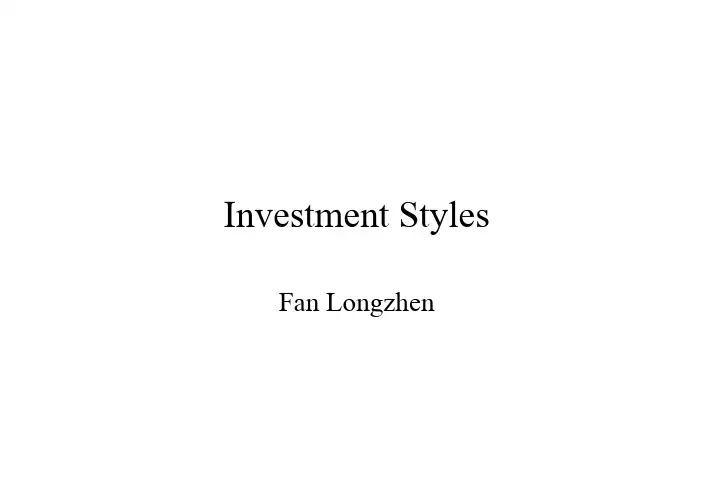
Investment Styles Fan LongzhenIntroduction•Overview of investment styles;•Empirical evidence on returns of small capitalization firms and value stocks;•How to identify investment styles of a mutual fund –Characteristic-based style analysis–Return-based style analysis•Style benchmarks•Why value stock outperform growth stocks;•Earning and price momentumTypes of investment styles •Growth investing–Primarily concerned with the earning component of the P/E ratio–Look for high growth rate•Value (non-growth) investing–Primarily concerned with the price component of theP/E ratio–Look for cheap stocks•Small cap investing (as opposed to large cap)–Looking for neglected stocks–Undervalued relative to large cap equitiesInvestment styles•Value:–low price/book; low P/E; utilities industry •Growth: high EPS Growth–high profitability; health & technology •Small capitalizationWhy style analysis?•Returns of stocks in one category (e.g. growth) behave quite differently from stocks in another category (e.g. value)•Style analysis facilities–Monitoring style characteristics;–Diversification and risk control;–Performance valuation•In September 2001, a total of 3271 domestic equity managers participated in the survey–962 identify themselves as value managers;–1124 identify themselves as growth managers.Returns of small capitalization stocks•Fama and French (1992)–Rank the stocks into ten deciles based on marketcapitalization every year;–Compute the average 1-year holding period return after portfolio formation.–Found small stocks have higher returns than big stocks(1963-1991)–Fama and French do a secondary sort by beta withineach size decile, and find that beta can not explain thereturns.Return of high/low book-to-market stocks•Fama and French (1992, Journal of finance)–Rank stocks into ten deciles based on book-to-market ratio every year;–Compute the average 1-year holding periodreturn after portfolio formation;–Value stocks have higher average returns thangrowth stocks.Morningstar Fund Analysis •Market capitalization classification–Step 1: rank all stocks based market capitalization •Top 5% of the stocks as large cap;•Next 15% of the stocks are medium cap;•Remaining 80% of the stocks as small cap.---step 2:assign a score of 3 for large-cap stocks, 2 for mid-cap stocks, and 1 for small-cap stocks.---step3: calculate the weighted average of the market cap score across all stocks in the fund.---Step 4: classification•If market cap score<1.5 small cap fund •If 1.5<market cap score<2.5 medium cap fund•If market score>2.5 large cap fund ⇒⇒⇒Morningstar Fund Analysis •Growth/value classification–Step 1: estimate mediam P/E and P/B ratio of the stocks in three market-cap groups;–Step 2 compute the P/E and P/B score for each stock: divide each stock’s P/E and P/B by the median P/E and median P/B (respectively) of the stock’s market-cap group;–Step 3 calculate the average P/E and P/B score for each fund: average P/E or P/B score is 1.–Step 4 combined score=P/E score +P/B score –Step5 classification•If combined score>2.25 growth fund •If 1.75<combined score<2.25 blend fund •If combined score<1.75 value fund ⇒⇒⇒Return-based style analysis •Based on multiple factor model:•Where =return on fund •= return on style benchmark k •How to estimate the style exposure?–Regression of fund I on the return of style benchmarks;•Unconstrained regression•Constrained regression ( )•Quadratic programming ( )i K iK i i i e F b F b F b R ~~...~~~2211++++=i R ~k F ~1=∑ik b 0,1>=∑ik ik b bStyle benchmark•Six style index–S&P 500/Barra growth and value–S&P midcap 400/Barra growth and value–S&P smallcap 600/Barra growth and value•Growth and value indexes are constructed by dividing the stocks in the corresponding basic index based on book-to-price ratio. Each company in the index is assigned to either the value or growth index so that the two style add up to the full index.•The growth and value indexes are constructed so that they have the same market capitalization. Since growth companies are bigger than value companies, there are many more companies in the value index than the growth index.。
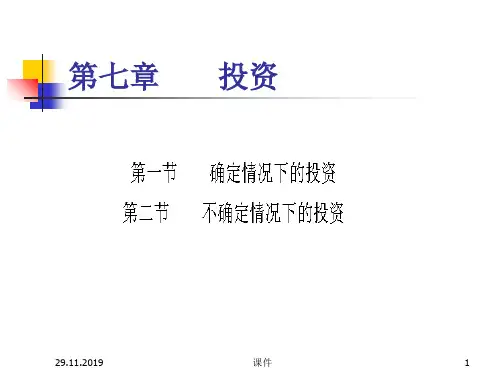
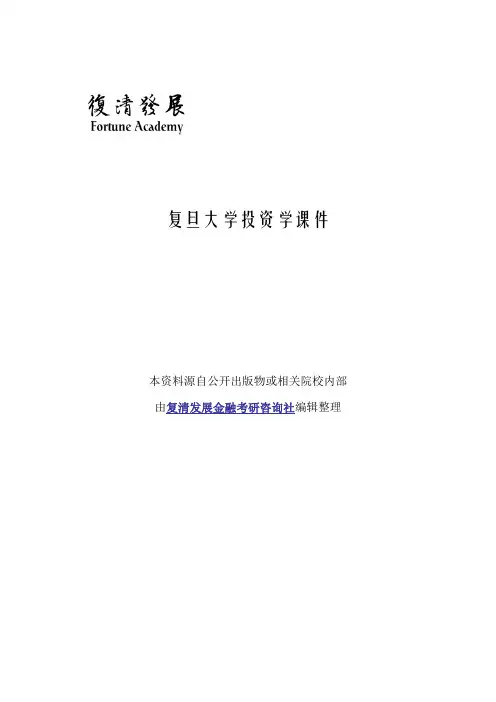
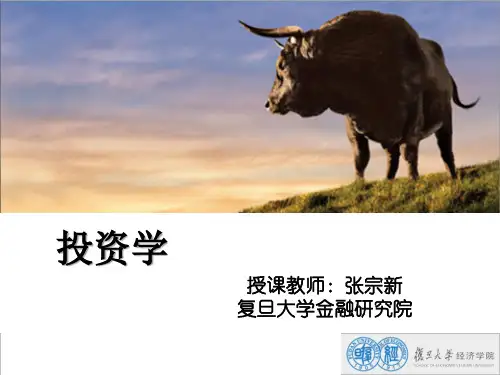
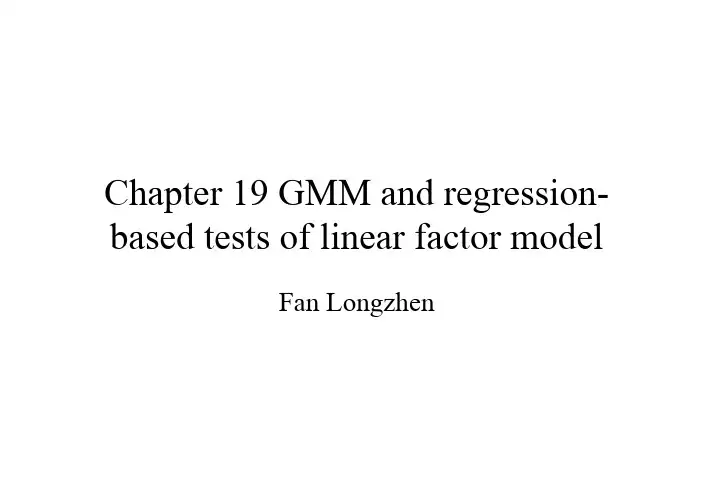
Chapter 19 GMM and regression-based tests of linear factor modelFan LongzhenNumber of parameter and Number of equation•If the number of parameter a is the same as the number of the equations r, we simply estimate θby solving•Usually r>a, so we have to set estimates to minimize the0);ˆ(=ΥTT g θ)];([)]';([);(T T T T g W g Q ΥΥ=ΥθθθOptimal weighting matrix•The optimal weighting matrix is the inverse of asymptoticvariance of •It turn out to be•Where •If were serially uncorrelated, then the matrix S could be consistently estimated by),(0T g Υθ{}∑∞−∞=∞→Γ=ΥΥ=v vT T t g g TE S )]';()][;([00lim θθ{})]',()][,([00v t t v y h y h E −=Γθθ{}∞−∞=t t y h ),(0θ(){})]',()][,([/1001*t t Tt Ty h y h T S θθ∑==Using GMM for regressions•OLS pick parameters to minimize the variance of the residual:•is derived from the first-order condition,which states that theresidual is orthogonal to the right-hand variable•This condition is exactly identified-the number of moments equals thenumber of parameters,thus we set the sample moments exactly to zero, and solve the estimate analytically,•The rest of the ingredients are •β{}])'[(2min t t T x y E ββ−β)]'([)ˆ(ββt t t T T x y x E g −=[])()'(ˆ1t t T t t T y x E x x E −=βtt t t t t t t e x x y x x f x x E d =−==)'(),(),'(ββRegression-based tests of linear factormodels-time series regression•For simple, consider a model with a single factor, we all use excess returns. The beta are defined by regression coefficients •(1)•The model states that expected returns are linear in the betas:•Since the factor is also excess return, the model applies to the factor as well, so •The model has one and only one implication for the data: all the regression intercepts should be zero;•Black, Jensen, and Scholes (1972) suggested a natural strategy for estimation and evaluation: run time-series regressions for each asset, the estimate of the factor risk premium is just the sample mean of thefactor:•Then use standard t-test to test if the intercept is zero .i t t i i ei t e f R ++=βα)()(f E R E i ei β=λ×=1)(f E )(ˆf E T=λDerivation of the Chi-square statistic, anddistributions with general errors•It derived it with GMM. This approach allows us togenerate straightforwardly the required corrections for auto correlated and heteroskedastic disturbances. It also serves to remind us that one can do a GMM estimate of an expected return-beta model.•Write the equations for all N assets together in vector form•We use the usual OLS moments to estimate thecoefficients t t e t f R εβα++=0])[()()(=⎟⎟⎠⎞⎜⎜⎝⎛⎥⎦⎤⎢⎣⎡=⎥⎥⎦⎤⎢⎢⎣⎡−−−−=t t t T t t e tT t e t T T f E f f R E f R E b g εεβαβαCross-sectional regressions •Start with the K-factor model, written as•The central economic question is why average returns vary across assets; expected returns of an asset should be high if that asset has high betas or a large risk exposure to factorsthat carry high risk premia;•For the case of a single factor CAPM, the model says the avergae returns should be proportional to betas, so plot the sample average returns against the betas. Even if the model is true, this plot will not work out perfectly in each sample, so there will be some spread as shown.•Given this fact, a natural idea is to run a cross-sectional regression to fit a line through the scatterplot of the figure.N i R E i ei ,...,3,2,1)('==λβcontinued•First find estimates of the betas from time-series regressions•Then estimate the factor risk premia from a regression across assets of average returns on the betas ,•As in the figure, are right-hand variables, are theregression coefficients, and the cross-sectional regressionresiduals are the pricing errors. This is known as a two-pass regression estimate. ieach for T t f R i t t i i eit ,...,2,1'=++=εβαλi i ei T R E αλβ+=')(βλi αDerivations and formulas for the variance ofestimated parameters•The easy and elegant way to account for the effects of the generated regressors such as beta is to map the whole thing into GMM.•To keep the algebra manageable, I treat the case of a single factor. The moments are⎥⎥⎥⎦⎤⎢⎢⎢⎣⎡=⎥⎥⎥⎦⎤⎢⎢⎢⎣⎡−−−−−=000)(])[)()(βλββe t t e t t e t T R E f f a R E f a R E b g。
